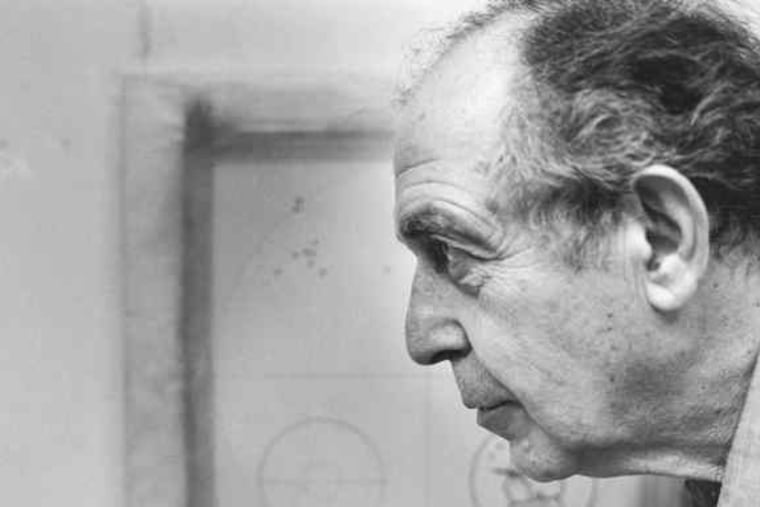An artist whose work spanned decades, styles
"Thomas Chimes' art is, to paraphrase Winston Churchill, a riddle wrapped in a mystery inside an enigma," Inquirer art critic Edward J. Sozanski wrote in 2007.

"Thomas Chimes' art is, to paraphrase Winston Churchill, a riddle wrapped in a mystery inside an enigma," Inquirer art critic Edward J. Sozanski wrote in 2007.
After a 2007 interview with Mr. Chimes, Inquirer reporter Amy S. Rosenberg wrote that in his work, "there's always another idea, another citation, another memory, another theory, another poet or artist to bring toward the surface, then submerge again, behind layers of paint or layers of ideas, until just barely visible, a reduction."
Both encounters with Mr. Chimes took place during the two-month retrospective that the Philadelphia Museum of Art staged of nearly 100 of his paintings, metal box constructions, and works on paper.
Last week, Michael Taylor, the museum's curator of modern art, who staged that show, said simply, "He was the dean of Philadelphia contemporary artists."
On Tuesday, his 88th birthday, Mr. Chimes died of melanoma at the Wissahickon Hospice in Center City.
His son, Dmitri, who owns two Philadelphia restaurants named Dmitri's, recalled that his father "described himself as a hermit" because "a hermit is someone who lives where the wild things are."
He was also a leader among artists. As Taylor said: "That was the kind of double story with him.
"One was the artist who was a hermit and needed to create the work he did," while living in an apartment on Washington Square. "The other was this garrulous intellectual who was a great storyteller."
He hadn't outlived his time, Taylor said, "because he kept his work so fresh and invigorated with new ideas. And he painted to the very end."
Taylor said his favorite work was a painting from a photograph of Alfred Jarry that Mr. Chimes had reworked into his own oil-on-panel creation.
Sozanski wrote: "Chimes' primary inspiration has been Alfred Jarry (1873-1907), a French poet and playwright whose play Ubu Roi caused a riot when it opened in Paris in 1896.
"Jarry believed that writers should reject intelligence in favor of hallucination, and he advocated defiance of authority through absurdity and incoherence."
Most of the work in the 2007 retrospective, Sozanski wrote, "revives and reconfigures the agenda of symbolism, a mainly literary movement of a century ago that attempted to suggest ways that people could enter the spirit world."
And so the show offered a time line of Chimes' works. First abstractions, often including some form of a crucifix. Then wall-mounted metal constructions. Then 48 of the painted panels like that of Jarry, based on photos of Edgar Allan Poe, Oscar Wilde, Marcel Proust.
And then white paintings in which, Sozanski wrote, "characters appear as ghostly presences," suggesting "acts of meditation by the artist."
The Art Museum's Taylor saw several careers in the Chimes show.
"Any lesser artist could have been justified to keep going in any one of those styles that he invented," Taylor said.
"But I think Tom always felt he didn't want to repeat himself, even though it would have been better commercially to have kept to one style. . . . When he changed style, he had to. He had no choice in the matter."
Mr. Chimes' parents were Greek immigrants - Demetrius Tsamis and Aglaia Colokythas - who changed the family name to Chimes when they married. Mr. Chimes' father ran a seafood restaurant in Brewerytown, moved to Georgia, and returned to reopen the restaurant, which then failed in the Great Depression.
The catalog for the 2007 show states that the future artist attended the Mastbaum School of Art and graduated from West Philadelphia High School in 1936.
He was much on the move.
Mr. Chimes entered the Pennsylvania Academy of the Fine Arts in 1936; withdrew after a disagreement with an instructor; enrolled in the Art Students League in Manhattan in 1941; earned an aircraft mechanic's license in South Carolina, where his family had opened a dry cleaning business; and, in 1943, enlisted in the Army Air Forces.
He returned to the Art Students League in 1946; completed his work in 1948; worked at an aunt's West Philadelphia cafe, taught landscape painting in Chautauqua, N.Y., in 1950; and in 1952 traveled with his wife and son to Greece and later took an apartment in Paris.
Finally, in 1953, he returned to Philadelphia, where he lived the rest of his life.
He joined the Moore College of Art faculty in 1971, and in 1974 he became chairman of the sculpture department at Moore, where he taught until 1982.
Critiquing Chimes' last one-man exhibition before the Art Museum retrospective - at the Locks Gallery in Philadelphia in 2005 - titled "Thomas Chimes: Confronting the Unconscious: Early Works, 1958-1965," Sozanski wrote, "Looking at this show is like attending a religious service in a language you don't understand."
Besides his son, Mr. Chimes is survived by two grandchildren and his former wife, Dawn. Their daughter, Eva, died in 2000.
A memorial is planned for an undetermined date in September at the Locks Gallery.
See a slide show of Thomas Chimes' work at
http://go.philly.com/chimesEndText